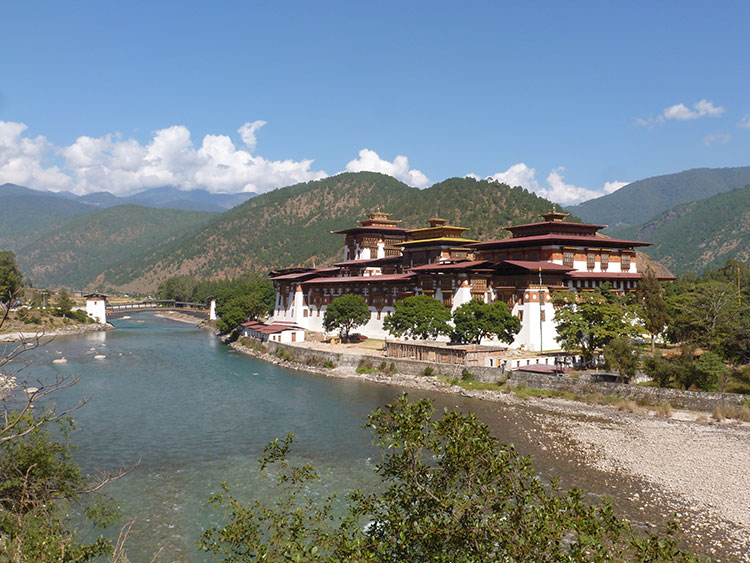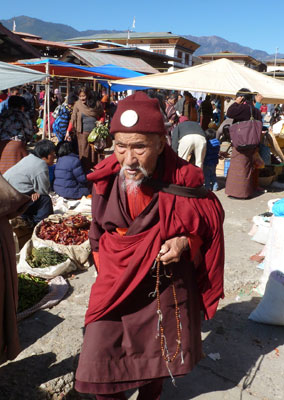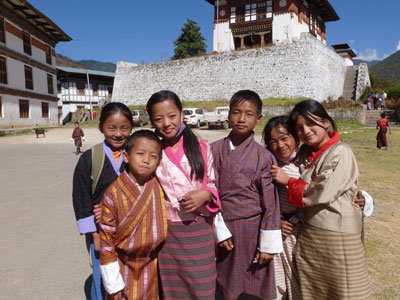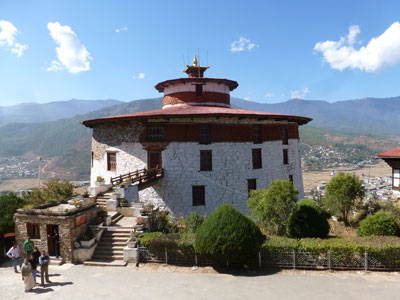Priceless experiences outweigh the higher cost of travel to Bhutan
by Kerry Brock; Santa Fe, NM
Bhutan was on our travel short list for a long time because we couldn’t seem to justify the expense. However, having made the trip in October-November 2012, my wife, Mary, and I now believe Bhutan is a good value!
A few details
How did our opinion change? Bhutan is possibly the most wonderful combination of places, sights and people in the world, and everything that makes a visit wonderful and interesting was included in the tour price. For the two of us, the total land cost for our 14-day private tour was $7,140.
Mary and I travel “close to the ground.” We are value conscious and enjoy rubbing elbows with the locals. That combination allows us to travel farther and longer, so when we get home we feel like we’ve gotten to know the country and its people.
During our early planning for our trip to Bhutan, we set out to create a “value travel” experience that would allow us to do exactly what we wanted to do. For $255 per person per day, we ended up having an outstanding private guide, Chimi Rinzin, a driver, Gembo Dorji, and excellent accommodations (about 3-star equivalents) plus all food and nonalcoholic drinks and transportation in a Toyota Land Cruiser.
To visit Bhutan, you must have an authorized guide, stay at authorized places and eat at authorized restaurants. For 2012, the government of Bhutan set the minimum price of all tour packages, which must be booked through approved tour operators, at $250 per person per day in high season. For any small group, as in our case, there is an additional cost of $30 per person per night. (You can find the latest prices on this website.)
Cost versus value
So how could we make this trip a good value?
First, we read our Lonely Planet guidebook cover to cover, identifying the places that fit our interest and the accommodations that seemed to be our style. Using that information, we put together three lists: “Must,” “Desirable” and “If We Can.”
Then we did an extensive search and comparison of tour companies, making sure some of them were internal to Bhutan. We sent each of those companies our lists and asked their opinion and for a price quote.
Our interchanges with the five competing companies allowed us to refine our lists so the final quotes could be fairly compared.
We made a great choice in the local company Bhutan Mountain Holiday (Thimphu; phone +975 2 320 115). I worked directly with the owner, Karma Gyeltshen, via email (karmagyeltshen@hotmail.com) during the whole process. We arranged the whole trip, with deposit and airline reservations, 300 days in advance of our arrival.
I ended up with a significant discount over the “normal” daily rate. Additionally, Karma threw in a horseback ride, a rafting trip and a hot-stone bath. The accommodation ended up being a combination of our and Karma’s choices.
Another big expense when traveling to Bhutan is airfare. Drukair is the only airline serving Bhutan.
We used frequent-flyer miles to Bangkok. The round-trip flight from Bangkok to the Paro airport, the only international airport in Bhutan, cost about $1,000 per person. Reserve your flight early!
First impressions
Chimi, our guide, met us at the airport with a smile, which got us off to a great start. Within minutes we were enjoying the unique and striking architecture of Paro Dzong (Rinpung Dzong).
Each of Bhutan’s 20 districts has a dzong, serving both as a fort or administrative headquarters and as a Buddhist monastery. Each dzong is unique, but all share the same general architectural style.
Whether they are perched high on a promontory or guard a critical river, every dzong has a lovely location. They were built to protect Bhutan from ancient invading armies, mostly those from Tibet.
The Paro Dzong, built in 1645, featured dual courtyards, meaningful murals and colorful temples.
Immediately we noticed the uniform architecture of all the surrounding houses, mimicking the dzong’s design on a smaller scale. This applied to homes throughout Bhutan.
Additionally, it struck us that the majority of people wore traditional clothing: ghos for men and kiras for women. What a magical kingdom!
The Ugyen Phendeyling Resort was a perfect base for the next three nights. The forward view from our second-story room was of Tiger’s Nest, a monastery situated on the side of a sheer cliff 900 meters above the Paro Valley. To the right, the view was of the snowy Himalayas against a brilliant blue sky.
Tiger’s Nest
Our horseback ride up to Tiger’s Nest began early the next morning. Chimi worked hard to assure that we were the first ones up the path. Each turn — and there were many — provided a spectacular view across the valley.
The path up the mountain was narrow and without guardrails. In addition, the horses had full and exclusive control. As riders, we did not even touch the reins, which simply hung around the horses’ necks. This is not a ride for anyone concerned about heights or who has a fear of falling.
The horses could go only as far as a ridge located across a gorge from Tiger’s Nest, so we had to climb the last hour on our own. We also had to walk all the way back down to prevent the horses from possibly hurting themselves hauling us down.
There must have been a million prayer flags strung across the gorges, adding color and movement to the landscape.
As at all temples and various other sites in Bhutan, visitors must remove their shoes and socks, wear appropriate clothing and show respect. Locals, themselves, are not allowed in the dzongs, monasteries, temples and government buildings unless they are wearing traditional dress.
On the road
On the way out of Paro we visited the Sunday market. If you love markets like we do, this one is not to be missed!
Our fourth day in Bhutan featured an easy drive to Thimphu, the capital. There were lots of museums, factories and other places to visit there.
The Peaceful Resort was lovely, but dogs barking at the full moon all night forced us to wear earplugs. Many places in Bhutan seemed overrun with stray dogs. At no time were we intimidated by them, but you should not pet them.
The mention of animals brings me to an interesting element of the Buddhist influence there. In Bhutan, the killing or harming of any sentient being is not allowed. You are not allowed to fish (not even catch and release), for fear of harming the fish. Great care is taken to be sure trek horses are not uncomfortable or misused.
Nothing is to be butchered in Bhutan. Cracking eggs is okay, but you cannot kill the chicken. So how do they get their meat? Simple! They buy it already butchered from India.
Speaking of food, Bhutanese cuisine is basic and good tasting but nothing to write home about. Make an effort to ask for local dishes. Chilies are intensely hot and available to tourists generally only on request. One favorite dish of ours was chilies with cheese over almost anything.
On our sixth day we drove to Trongsa in central Bhutan. The long, 6-hour drive was broken up by wonderful vistas, a lunch stop, Pelela Pass and a visit to Chendebji Stupa.
Well worth the journey, Trongsa is built into a mountainside and features an exceptional dzong. Our guest house, Tashi Ninjay, was wedged into the hillside just above the dzong and offered a world-class view from our balcony.
Visits to the Tower of Trongsa Museum, even farther up the mountainside, and the town, itself, were done by noon. Then we drove 2½ hours to the Bumthang Valley, stopping at various interesting places along the way. Close to the town of Jakar, we stayed at the Gongkhar Guest House for four nights. This guest house was perfect — great food, an attentive staff and a homey atmosphere.
Festival fun
The highlight of our trip was the Jampey Lhakhang Festival, held at a temple of the same name, the oldest in Bhutan. The festival was a full day of sensory overload!
We arrived early and sat on the ground next to the ropes outlining the performance area of the large courtyard. Welcome dances performed by local women in their finest kiras started about 9 a.m. as the crowd swelled to over 2,000.
We were part of the sea of friendly kids, smiling old folks and hundreds of welcoming Bhutanese. The young people wanted to practice their English, which they had been taught in school from the age of five.
Each festival dance had unique, colorful costumes and a message to tell. Important principles of Bhutanese religion and myths were presented through dance as a way of passing the teachings to the general population. Dancers wore elaborate masks, played drums and thrilled us for hours.
To stretch our legs, we walked around the all-encompassing market with arcade-type vendors, allowing even more people-watching opportunities.
While many of the big festivals take place on days set in advance, the dates of local festivals may change at the last minute.
Day-tripping
From our base in the Bumthang Valley, we took a long day trip to the Tang Valley, traveling over a rough dirt road to enjoy the very rural setting and the famous Ogyen Choling Palace Museum. A hike down into the Tang Valley ended with lunch along a small river as we watched farmers working their fields with oxen and wooden plows.
Taking off in other directions from our Bumthang Valley base, we explored several communities and sights during perfectly sunny but crisp days. We would stop by a wine shop in town at the end of each busy day to buy local and Indian brands to try with that night’s meal, sharing with our hosts and guides. After dinners containing a wide variety of local entrées, we enjoyed our cozy, woodstove-heated room.
On our 11th day of the trip, we started the 6-hour drive returning west to Punakha-Wangdue Valley.
Bhutan is shaped like an oval running east to west, with several mountain chains running north to south. That makes road building difficult, so there are few and they are hard to maintain.
Most passes on which we traveled included yak encounters as well as postcard views of green mountains backed by the Himalayas set against the high-altitude blue sky. On the roads, we really needed our tough car and great driver!
An important stop during this long journey west was the Phobjikha Valley to see the famous migratory black-necked cranes. From a viewing hut with high-power scopes, we were fortunate to watch a small flock for a couple of hours. Then we drove on to Punatsangchhu Cottages in Punakha for a restful night beside the river.
After visiting the hilltop Walakaha Nunnery and a couple of other sights, we drove upriver for our rafting trip back to the Punakha Dzong. More like a float trip with a few rough spots, this rafting trip was not adventurous but was certainly beautiful, with several bird sightings and an entertaining boatman. Drifting by the dzong and under its bridge was a photo highlight.
We disembarked and finished our return drive to Thimphu in about two hours for another night at Peaceful Resort — without the barking dogs.
Unique experience
The takin is Bhutan’s national animal. At a preserve in Thimphu, we watched a new mother nursing her calf and observed this truly unique creature.
Just outside the preserve was a young woman, Kezang Wango, weaving on a backstrap loom. She provided us with scarves for all our “girls” back home.
Kezang was just one of many craftspeople we met throughout the trip. Goods were unique and inexpensive, but not cheap.
In the afternoon we visited a local farmhouse and enjoyed a private hot-stone bath. Stones heated in a log fire were placed in an old wooden tub, though it was a little short for tall people. Soaking in the hot water as long as we wished was relaxing.
Spending two weeks in Bhutan was worthwhile, exciting and entertaining. We learned a lot about the country, its people and its culture.
Chimi, our guide, answered a million questions — several of them multiple times. His patience, kindness and knowledge were magic.
We highly recommend Karma Gyeltshen of Bhutan Mountain Holiday for arranging a visit to Bhutan.
As with every trip we take, we create a detailed spreadsheet with each day’s information. If you would like more information about this trip, email me c/o ITN.





